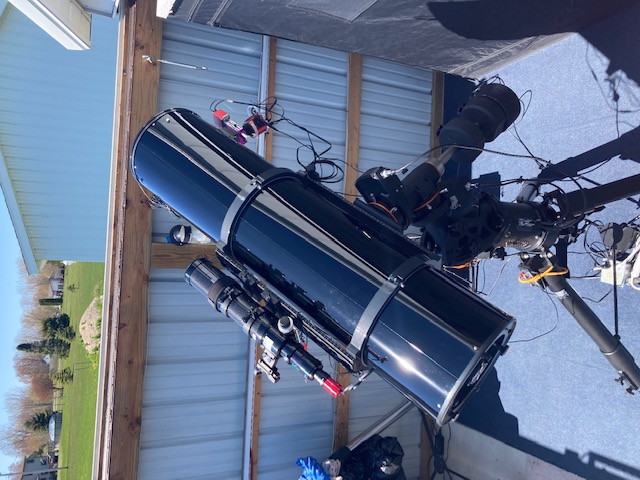Suggestions PLEASE!
32 views
Skip to first unread message
Dale P
May 10, 2021, 10:14:23 AM5/10/21
to Open PHD Guiding
Hello everyone!

1st, before I posted here I have tried many times (over the course of 2 months) to figure this out so I didn't have to bother all you guys but I'm just at my wits here and am looking for some suggestions, and maybe understanding... I'll do my best to explain my situation/problems.
I have had good success with my calibrations with my CGE PRO/OnStep mount. Once I go thru the calibration and it starts to guide and settle in so to speak the numbers total RMS are generally under .7".
However when you look at the RA and Dec RMS numbers the RA is always much larger then the Dec axis. When you look at the images taken they always have oval stars. I've looked at my individual frames and the stars range from being round to being oval in both RA & DEC directions. Now I know this is a very common thing but I cannot for the life of me get these numbers to come in much closer to each other. The result is always oval stars with the RA axis at least 40-50% larger then Dec. I know the closer the 2 axis' are to each other the more round the stars reguardless of the actual number so to speak.
Something that I have noticed is when I go to a different part of the sky the numbers are always different of course and in the end I either recalibrate which sometimes works and sometimes it does not. In most cases I have to recalibrate or force calibrate to make the numbers get even a little better after the move from where I took the original calibration for the evening. Also I always seem to have a few minutes that look good then both axis' take a ++++ and then come back as if there is a cycle. At least thats kinda what it seems like to me. I don't know how to fix this so suggestions please.
My general process flow is, once I have calibrated I will use the Guiding Assistant at least 1 time and if I like the numbers I'll go with it, but in 50-60% of the time will run a second guiding assistant and adjust to get things the best I can get and go with that. Again still producing oval stars. For your information to help me, I've attached my log file, setup specifics and a quick snapshot of the mount/ota/tripod to look at. I'm hoping with many more eye's on my setup you guys can help me trouble shoot why I ALWAYS have oval stars with this mount.
Mount: CGE Pro/OnStep conversion
Main OTA/Camera: 12" Newt. DBA Certified/Swayze primary w/zwo294mc pro
Guide Scope & camera: Orion CF 80ed w/zwo290mini
I would like to thank you ALL that respond in advance to my post!
Dale

Brian Valente
May 10, 2021, 10:59:33 AM5/10/21
to Open PHD Guiding
Hi Dale

Is it possible to post a link to one of your example images showing the oval stars?
what is the image scale of your main telescope?
I looked at your longest run of 70 minutes and looked at the first half of the guiding run and it averaged 0.55" RMS

Unless you are imaging at a very fine image scale, This should have produced round stars. If you have noticeably oval stars without fail, it could be differential flexure, which seems a likely candidate looking at your setup
Here's a link that explains it and how you can test for it
Brian
--
You received this message because you are subscribed to the Google Groups "Open PHD Guiding" group.
To unsubscribe from this group and stop receiving emails from it, send an email to open-phd-guidi...@googlegroups.com.
To view this discussion on the web visit https://groups.google.com/d/msgid/open-phd-guiding/3ce552e1-b72b-4762-9f2b-5420e5d6d96an%40googlegroups.com.
bw_msgboard
May 10, 2021, 11:27:12 AM5/10/21
to open-phd...@googlegroups.com
I agree with Brian, this is probably caused by differential flexure. There’s another explanation of that in this document starting at the bottom of page 13:
https://openphdguiding.org/tutorial-analyzing-phd2-guiding-results/
Regards,
Bruce
--
Dale P
May 10, 2021, 11:46:48 AM5/10/21
to Open PHD Guiding
Hello Brian
Thanks for your input! I didn’t want to post that thought (didn’t want to put an idea in you guy’s head) but that was in the back of my mind.
Yes I’ll post a couple of pix but they are large files.
Image scale is .554
The working FL of the main scope is 1725mm
The working FL of the guide scope is 480mm
Dale
Dale P
May 10, 2021, 11:47:49 AM5/10/21
to Open PHD Guiding
Thank you Bruce for your input!
It looks like I’ll have to do some testing for this I guess.
Dale
Brian Valente
May 10, 2021, 11:50:59 AM5/10/21
to Open PHD Guiding
Dale please post only links to your images, they won't be uploadable to the forum
>>>The working FL of the main scope is 1725mm
Personally i would 100% be using an OAG at this focal length
To view this discussion on the web visit https://groups.google.com/d/msgid/open-phd-guiding/65f56554-024f-4afd-a9ee-f010318508a5n%40googlegroups.com.
Dale P
May 10, 2021, 12:08:51 PM5/10/21
to Open PHD Guiding
Hello Brian
Ok on the links. I guess I’ll need to put them in Google Drive then. I don’t have a AP page. Not that good! LOL
A friend of mine had mentioned that too, but I’m using a paracorr for a FF so I figured that an OAG would be not such a good fit for my setup.
I also had thought about machining another set of support rails that would mount 180º apart but 90º from the main Dovetail bars for added rigidity but I don’t know how much difference that would make.
I’ll try to get the images uploaded to Drive and get a link posted here in a bit.
Dale
Reply all
Reply to author
Forward
0 new messages
